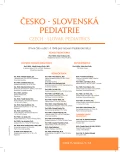Invasive pneumococcal diseases in Slovakia in years 1997–2015
Authors:
E. Bottková 1,3; K. Králinský 2,4; L. Maďarová 1; C. Klement 1,3; M. Avdičová 1; S. Feiková 4; M. Mačaj 5; Ľ. Perďochová 6; H. Hudečková 7
Authors‘ workplace:
Regionálny úrad verejného zdravotnictva, Banská Bystrica, regionálny hygienik a vedúci prof. MUDr. C. Klement, CSc.
1; II. Klinika pediatrickej anesteziológie a intenzívnej medicíny SZU, Detská fakultná nemocnica s poliklinikou, Banská Bystrica, prednosta prof. MUDr. K. Králinský, PhD.
2; Fakulta verejného zdravotníctva, Slovenská zdravotnícka univerzita, Bratislava, dekanka doc. MUDr. Š. Moricová, PhD. MPH, mim. prof.
3; Fakulta zdravotníctva, Slovenská zdravotnícka univerzita, Banská Bystrica, dekanka doc. PhDr. B. Frčová, PhD., MPH
4; ORL oddelenie, Nemocnica Sv. Michala, Bratislava, primár doc. MUDr. P. Doležal, CSc., mim. prof.
5; HPL, spol. s. r. o., Bratislava, vedúci oddelenia bakteriológie RNDr. P. Pavlík, MHA
6; Ústav verejného zdravotníctva, Jesseniova lekárska fakulta v Martine, Univerzita Komenského v Bratislave, Martin, vedúca ústavu prof. MUDr. H. Hudečková, PhD., MPH
7
Published in:
Čes-slov Pediat 2016; 71 (7-8): 354-360.
Category:
Original Papers
Overview
Aim of the study:
The aim of the study is to summarize epidemiological situation and to evaluate surveillance progress of invasive pneumococcal diseases (IPD) in Slovakia during the time period 1997–2015.
Methods:
The analysis of epidemiological situation regarding IPD in years 1997–2015 and results of laboratory testing of S. pneumoniae strains isolated from invasive pneumococcal diseases in years 2008–2010 and 2011–2015 in Slovakia. HPL laboratories network determined serotypes of invasive bacterial isolates from 51 patients (quellung reaction) during 2008–2010. NRC diagnosed 317 bacterial isolates respectively biological materials (latex agglutination, quellung reaction, multiplex PCR) during 2011–2015.
Results:
The highest IPD incidence in years 1997–2015 was noted in age groups of 0 year children, 1–4 year children and persons over 65 years. Invasive S. pneumoniae strains were most commonly isolated from hemoculture and CSF. The most frequent causal serotypes of IPD in 2008–2015 were 3, 19A, 14 and 7F.
Conclusions:
Average IPD incidence in Slovakia in years 2011-2015 represents 1.25/100 000 and still is influenced by underreporting. Ongoing and continuous monitoring of causal ser otypes causing IPD remains necessary.
Key words:
Streptococcus pneumoniae, invasive pneumococcal diseases, vaccination, serotypes
Sources
1. World Health Organisation: Global immunization data. http://www.who.int/immunization/monitoring_surveillance/Global_Immunization_Data.pdf. Accessed July 21, 2015.
2. O‘Brien KL, Wolfson LJ, Watt JP, et al. Burden of disease caused by Streptococcus pneumoniae in children younger than 5 years: global estimates. Lancet 2009; 374 (9693): 893–902. doi: 10.1016/S0140-6736(09)61204-6.
3. World Health Organisation. Pneumococcal conjugate vaccine for childhood immunization – WHO position paper. Wkly Epidemiol Rec 2007; 82 (12): 93–104.
4. Petroušová L, Rožnovský L. Pneumokokové infekce u dospělých a jejich prevence. Med praxi 2013; 10 (3): 104–107.
5. European Centre for Disease Prevention and Control. Surveillance of invasive bacterial diseases in Europe. Stockholm: ECDC, 2015.
6. Dagan R, Juergens C, Trammel J, et al. Efficacy of 13 valent pneumococcal conjugate vaccine (PCV13) versus that of 7-valent PCV (PCV7) against nasopharyngeal colonization of antibiotic-nonsusceptible Streptococcus pneumoniae. J Infect Dis 2015; 211 (7): 1144–1153. doi: 10.1093/infdis/jiu576.
7. Domingues CM, Verani JR, Montenegro Renoiner EI, et al. Brazilian Pneumococcal Conjugate Vaccine Effectiveness Study Group: Effectiveness of ten-valent pneumococcal conjugate vaccine against invasive pneumococcal disease in Brazil: a matched case-control study. Lancet Respir Med 2014; 2 (6): 464–471. doi: 10.1016/S2213-2600(14)70060-8.
8. Jokinen J, Rinta-Kokko H, Siira L, et al. Impact of ten–valent pneumococcal conjugate vaccination on invasive pneumococcal disease in Finnishchildren-a population-based study. PLoS One 2015; 10 (3): e0120290. doi: 10.1371/journal.pone.0120290.
9. Bottková E. Zavedenie sérotypizácie Streptococcus pneumoniae pomocou multiplexnej PCR. Rigorózna práca. Bratislava: PRIF UK, 2013 : 1–104.
10. Králinský K, Maďarová L, Bottková E, et al. Surveillance invazívnych pneumokokových ochorení na Slovensku v rokoch 2011–2015 s fókusom na detskú populáciu. Pediatria (Bratisl.) 2016; 11 (2): 103–105.
11. Deceuninck G, De Serres G, Boulianne N, et al. Effectiveness of three pneumococcal conjugate vaccines to prevent invasive pneumococcal disease in Quebec, Canada. Vaccine 2015, 33 (23): 2684–2689.
12. Pilishvili T, Lexau C, Farley M, et al. Sustained reductions in invasive pneumococcal disease in the era of conjugate vaccine. J Infect Dis 2010; 201 (1): 32–41.
13. Žemličková H. Streptococcus pneumoniae – vliv pneumokokových konjugovaných vakcín na výskyt antibiotické rezistence. Pediatr. praxi 2012; 13 (6): 424–426.
16. Šimurka P, Dluholucký S, Trupl J, et al. Invazívne pneumokokové infekcie u detí do 5 rokov na Slovensku. Detský lekár 2005; 2 : 19–23.
17. Trupl J, Hupková H, Bálint O, et al. Mikrobiologická a klinická analýza invazívnych pneumokokových infekcií v Slovenskej republike, 1996–1999. Klin mikrobiol inf lék 2000; 6 (8): 251–256.
18. Kozáková J, Šebestová H, Křížová P. Invazivní pneumokokové onemocnění v České republice v roce 2013. Informace z NRL a odborných pracovišť SZÚ. Zprávy centra epidemiologie a mikrobiologie. Praha: SZÚ 2014; 23 : 89–97.
19. Kozáková J, Šebestová H, Křížová P. Invazivní pneumokokové onemocnění v České republice v roce 2014. Zprávy centra epidemiologie a mikrobiologie. Praha: SZÚ 2015; 24 : 96–101.
Labels
Neonatology Paediatrics General practitioner for children and adolescentsArticle was published in
Czech-Slovak Pediatrics

2016 Issue 7-8
Most read in this issue
- TB meningitis in the Czech Republic – new encounter with an old diagnosis after 20 years
- The current situation in children TB in Slovakia
- Incidence of tuberculosis at children in the Czech Republic in years 2000–2015
- Tuberculosis in Children – some issues
